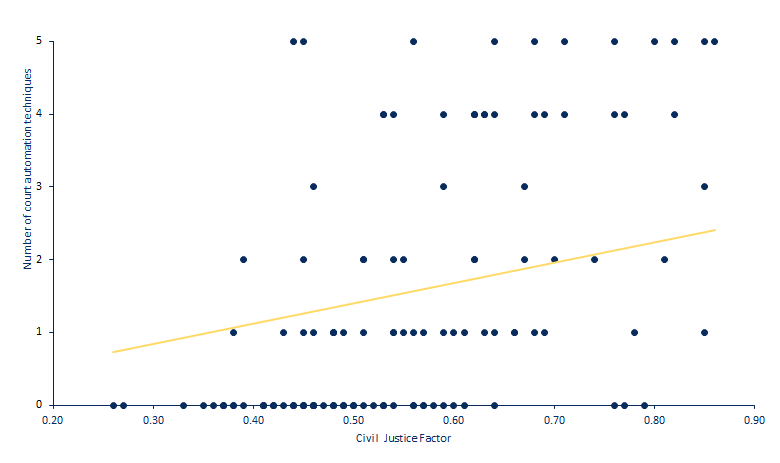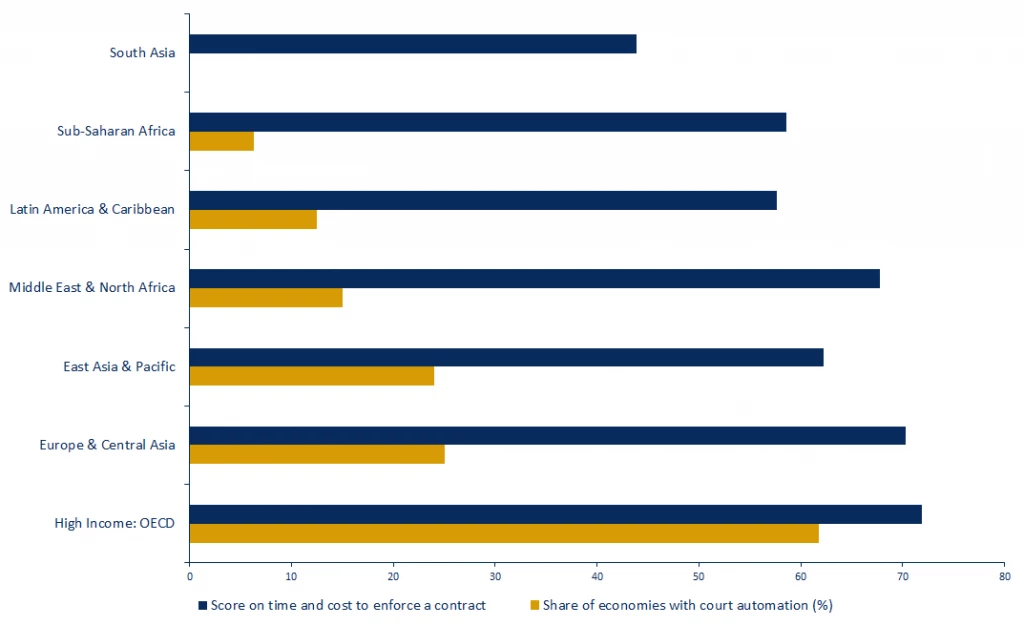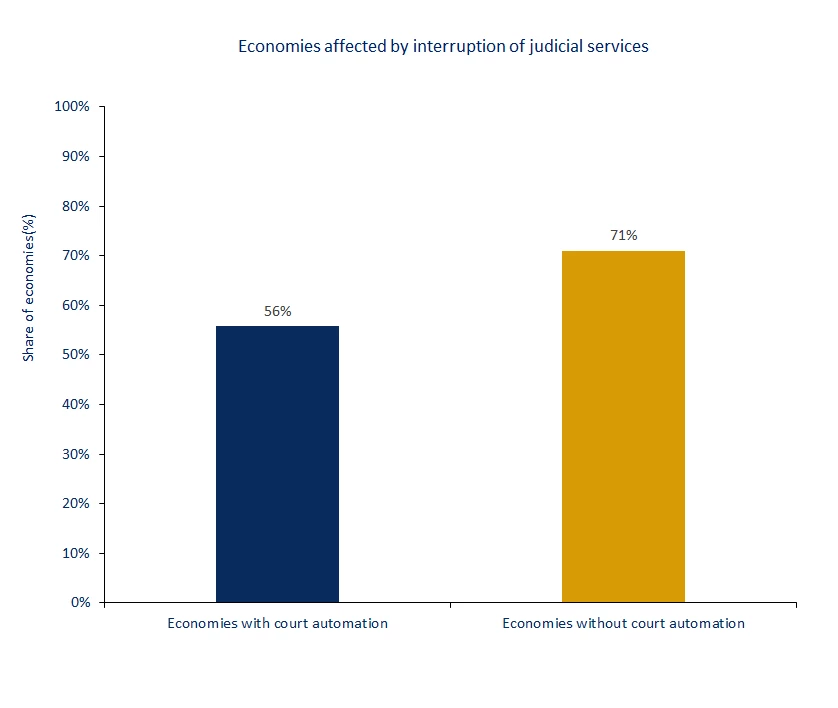 Justice theme with abstract high speed technology
Justice theme with abstract high speed technology
Empirical evidence shows that effective contract enforcement encourages investment in economic activities and promotes sustainable economic growth. Effective enforcement procedures enhance predictability in commercial relationships by assuring investors that their contractual rights will be upheld promptly by local courts. The opposite is also true. When procedures for enforcing contracts are cumbersome or contract disputes cannot be resolved in a timely and cost-effective manner, companies may restrict their operations. This, in turn, can have a negative effect on investment and growth.[1]
A critical element affecting a judicial system’s performance is court automation. Court automation could be defined as technology that reduces or eliminates human activities associated with the processing of judicial cases.[2] These technologies are by no means limited to basic equipment such as computers. In fact, they can encompass a variety of features, including electronic filing, electronic calendaring, an online notification center and many others. These features can be distinct or integrated into an electronic case management system (ECMS), which can support different case flow management techniques. This blog will focus on the following e-features that are measured by Doing Business: (i) filing an initial complaint (e-filing); (ii) serving the defendant with the initial complaint (e-service); (iii) paying court fees (e-payment) and managing cases via ECSM by both (iv) judges and (v) lawyers.
Court automation, when properly implemented, can lead to a significant reduction in the length and cost of judicial proceedings. Regions where more economies have put in place court automation techniques tend to have a higher median score on time and cost to enforce a contract (Figure 1). As can be seen, Organisation for Economic Co-operation and Development (OECD) high-income countries have the highest number of economies that have implemented at least three court automation features (62%). It is also the grouping with the highest median score on time and cost to enforce a contract (71.87).
FIGURE 1. Court automation is associated with less time and lower cost to enforce a contract.
Source: Doing Business 2020 database.
Note: The sample comprises 191 economies. Court automation is acknowledged when at least three of the following five features are available: e-filing, e-service, e-payment, ECSM for judges, and ECSM for lawyers.
Court automation can also make a significant contribution to improving access to justice. Specifically, it can provide free access to legislation and case law, streamline the exchange of documents and information, and ease dealing with judicial procedures overall. The data shows a positive correlation between the number of court automation techniques as assessed by Doing Business and access to justice as measured by the Civil Justice Factor of the World Justice Project (WJP) Rule of Law Index (Figure 2). As demonstrated by Figure 2, over 90% of economies that have not implemented any court automation techniques are in the 0.20 – 0.60 range on the Civil Justice Factor. At the same time, the vast majority of the economies that implemented more than four court automation techniques scored 0.60 or higher. The highest-scoring country, Denmark (Civil Justice score of 0.86), is also an economy that has put into practice all five court automation features discussed above. In Denmark, preparation and management of cases are conducted digitally through the courts’ web portal. Litigants must initiate cases via the portal by filling out special electronic forms with an option to pay court fees through the same system. All further communication between the court and litigants (including setting a trial date) is done through the portal as well.
FIGURE 2. Court automation is associated with better access to justice.

Source: Doing Business 2020 database and the Civil Justice Factor of the WJP Rule of Law Index. The latter measures whether civil justice systems are accessible, affordable, and free of discrimination, corruption, and public officials’ improper influence.
Note: The sample comprises 128 economies covered by the WJP Rule of Law Index.
Court automation also allowed economies to respond more efficiently to the rapid propagation of the COVID-19 pandemic. In many jurisdictions, the use of electronic means such as e-filing, e-service and electronic case management helped to ensure that court systems remained operational. To minimize COVID-19 impact on judicial operations, some economies went even further and rapidly adopted technologies that enabled video hearings using web-based platforms. In contrast, in most jurisdictions that lagged in terms of judicial automation, courts either shut down entirely or restricted their operations to essential or urgent matters only. The data collected shows that at the global level economies with court automation managed to avoid interruption of judicial services in approximately 44% of cases. In contrast, economies without court automation had to suspend commercial litigation in around 71% of cases (Figure 3).
FIGURE 3. Court automation helped the justice sector deal with the COVID-19 crisis.
Source: Doing Business 2020 database.
Note: The sample comprises 191 economies. Court automation is acknowledged when at least three of the following five features are available: e-filing, e-service, e-payment, ECSM for judges, ECSM for lawyers. Interruption of services is defined as practical impossibility to enforce a contract at a first instance court amid the COVID-19 crisis. The data on interruption of services reflect the situation as of May 1, 2020.
In summary, court automation carries several tangible benefits. Its implementation is associated with a faster adjudication of cases, reduced costs of litigation, and better access to civil justice. Moreover, economies with court automation were able to navigate better through the COVID-19 pandemic and, in many cases, ensured uninterrupted work of justice systems even during the most acute phases of the crisis. Court automation is also expected to play an important role in economic recovery, providing judges with more tools to clear the COVID-19 related backlog of cases in the months and years to come.
[1] Please see more on why efficient contracts enforcement matters at https://www.doingbusiness.org/en/data/exploretopics/enforcing-contracts/why-matters.
[2] Velicogna, M. Justice Systems and ICT: What Can Be Learned from Europe? (2007).






Join the Conversation